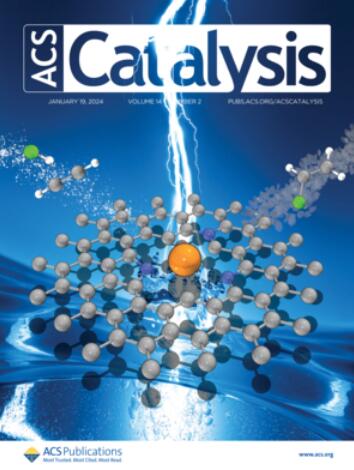Synergistic Effect of Ni Exsolution and Oxygen Vacancies in NiAl2O4 for Catalytic Transfer Hydrodeoxygenation of Furfural to 2-Methylfuran
IF 11.3
1区 化学
Q1 CHEMISTRY, PHYSICAL
引用次数: 0
Abstract
The exsolution of metal nanoparticles from solid lattices provides a strategy for designing efficient catalysts in catalytic transfer hydrodeoxygenation (CTHDO). This approach allows precise control over key catalytic properties, including nanoparticle density, surface acidity, and oxygen vacancies, which are crucial for the optimization of CTHDO reactions. We report a NiAl2O4-550 catalyst for the selective CTHDO of furfural (FUR) to 2-methylfuran (2-MF) with high selectivity. Using isopropyl alcohol (IPA) as a hydrogen donor, NiAl2O4-550 exhibited a high performance under favorable reaction conditions. Characterization (PXRD, Raman, TEM, XPS, NH3-TPD, Pyridine-FTIR, and H2-TPR/TPD) highlights the role of surface oxygen vacancies and exsolved Ni-metal in enhancing catalytic activity. XPS, O2-TPD, and EPR confirm their contributions to FUR conversion. DFT calculations reveal that oxygen-deficient sites improve substrate–catalyst interactions, lowering the energy barrier for FUR to 2-MF conversion. Under mild conditions (180 °C, 2 MPa of N2), NiAl2O4-550 afforded ∼99% FUR conversion with a 98.1% 2-MF selectivity, surpassing that of reported catalysts. The combination of oxygen vacancies and metal exsolution enables controlled transfer hydrodeoxygenation, offering an effective strategy for biofuel production. This study establishes a versatile platform for next-generation catalysts in environmentally conscious catalysis, contributing to advancements in catalyst design.

NiAl2O4中Ni外溶和氧空位对糠醛催化加氢脱氧制2-甲基呋喃的协同作用
金属纳米颗粒从固体晶格中析出为设计高效的催化转移加氢脱氧(CTHDO)催化剂提供了一种策略。这种方法可以精确控制关键的催化性能,包括纳米颗粒密度、表面酸度和氧空位,这对优化CTHDO反应至关重要。我们报道了一种NiAl2O4-550催化剂,用于糠醛(FUR)与2-甲基呋喃(2-MF)的选择性CTHDO,具有高选择性。以异丙醇(IPA)为供氢剂,在良好的反应条件下,NiAl2O4-550表现出良好的反应性能。表征(PXRD, Raman, TEM, XPS, NH3-TPD, Pyridine-FTIR和H2-TPR/TPD)强调了表面氧空位和外溶镍在提高催化活性中的作用。XPS、O2-TPD和EPR证实了它们对FUR转化的贡献。DFT计算表明,缺氧位点改善了底物-催化剂的相互作用,降低了FUR到2-MF转化的能垒。在温和条件下(180°C, 2 MPa N2), NiAl2O4-550的FUR转化率为~ 99%,2- mf选择性为98.1%,超过了已有报道的催化剂。氧空位和金属脱溶的结合实现了可控的转移氢脱氧,为生物燃料生产提供了有效的策略。本研究为环保催化领域的下一代催化剂建立了一个多功能平台,有助于催化剂设计的进步。
本文章由计算机程序翻译,如有差异,请以英文原文为准。
求助全文
约1分钟内获得全文
求助全文
来源期刊

ACS Catalysis
CHEMISTRY, PHYSICAL-
CiteScore
20.80
自引率
6.20%
发文量
1253
审稿时长
1.5 months
期刊介绍:
ACS Catalysis is an esteemed journal that publishes original research in the fields of heterogeneous catalysis, molecular catalysis, and biocatalysis. It offers broad coverage across diverse areas such as life sciences, organometallics and synthesis, photochemistry and electrochemistry, drug discovery and synthesis, materials science, environmental protection, polymer discovery and synthesis, and energy and fuels.
The scope of the journal is to showcase innovative work in various aspects of catalysis. This includes new reactions and novel synthetic approaches utilizing known catalysts, the discovery or modification of new catalysts, elucidation of catalytic mechanisms through cutting-edge investigations, practical enhancements of existing processes, as well as conceptual advances in the field. Contributions to ACS Catalysis can encompass both experimental and theoretical research focused on catalytic molecules, macromolecules, and materials that exhibit catalytic turnover.
 求助内容:
求助内容: 应助结果提醒方式:
应助结果提醒方式:


